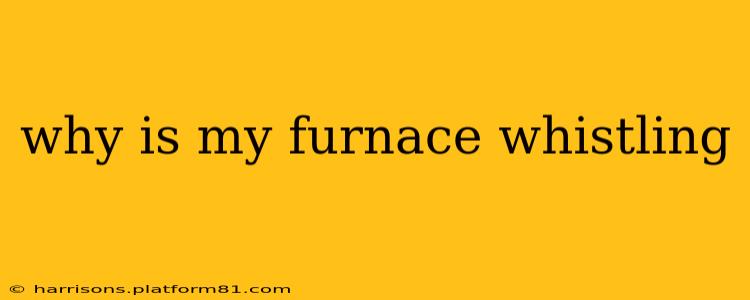A whistling furnace can be incredibly annoying, and more importantly, it could indicate a serious problem. This high-pitched sound isn't just a nuisance; it often signals a malfunction that needs immediate attention. This guide will help you diagnose the cause of your whistling furnace and determine the next steps.
Common Causes of Furnace Whistling
Several issues can cause your furnace to whistle. Let's explore some of the most frequent culprits:
1. Loose or Damaged Components:
A high-pitched whistle is often the sound of air rushing past a loose or damaged component. This could be anything from:
- Loose screws or panels: Check all screws and panels on your furnace. Tighten any loose screws and ensure all panels are securely fastened. A loose panel can allow air to escape, creating a whistling sound.
- Damaged blower motor: The blower motor's fan blades could be bent or damaged, causing them to vibrate and whistle as they spin. This requires professional attention.
- Worn bearings in the blower motor: Worn bearings create friction, leading to a high-pitched squeal or whistle. Replacing the blower motor is typically the solution.
2. Airflow Problems:
Restricted or uneven airflow can force air to squeeze through tight spaces, resulting in a whistling sound.
- Dirty air filter: A clogged air filter restricts airflow, increasing pressure and potentially causing whistling. Replacing your air filter regularly is crucial for maintaining efficient furnace operation and preventing whistling.
- Blocked vents or ducts: Obstructions in your ductwork or vents can also restrict airflow. Check for any blockages, such as furniture, debris, or even dust buildup.
- Leaking ductwork: Holes or cracks in your ductwork can cause air to leak out, altering air pressure and leading to whistling. Sealing these leaks is necessary to restore proper airflow.
3. Problems with the Heat Exchanger:
The heat exchanger is a crucial component responsible for transferring heat from the burner to the air. Issues with it can produce a whistling sound. This is a serious concern and requires immediate professional attention.
- Cracks in the heat exchanger: Cracks can allow combustion gases to leak into the living space, posing a serious safety hazard. A whistling sound, alongside other symptoms like unusual smells, could indicate a cracked heat exchanger.
4. Ignition Issues:
While less common, ignition problems can sometimes manifest as a whistling sound.
- Ignition problems: Issues with the gas valve or igniter can create a high-pitched whistle. This usually necessitates a professional HVAC technician’s assessment.
What to Do If Your Furnace Is Whistling
The first step is to identify the source of the whistle. Try to pinpoint the location of the sound within the furnace.
If you're comfortable doing so, check the obvious issues like loose screws, a dirty air filter, and blocked vents. Replace the air filter if it's dirty. However, if you're not familiar with furnace maintenance, or if the problem persists after basic checks, it's crucial to call a qualified HVAC technician.
When to Call a Professional
Don't hesitate to contact a professional if:
- You suspect a problem with the heat exchanger. This is a safety concern.
- The whistling sound is accompanied by other unusual noises or smells.
- You're uncomfortable working on your furnace yourself.
- The problem persists after attempting basic troubleshooting steps.
A qualified HVAC technician possesses the expertise to diagnose the exact cause of the whistling and implement the appropriate repairs or replacements, ensuring your furnace operates safely and efficiently. Remember, a little preventative maintenance can go a long way in preventing these problems from arising in the first place.
